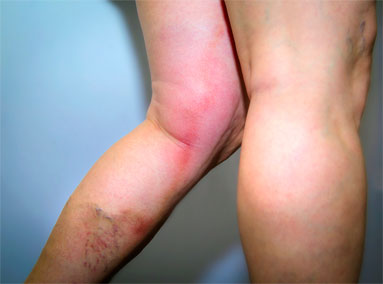Superficial Thrombophlebitis

Superficial thrombophlebitis (STP) refers to inflammation and clot formation in the superficial vein which runs under the skin. It commonly occurs in the varicose veins of the leg, but it can also occur in any superficial vein after an injury. This is a condition which usually resolves within 2-6 weeks. STP is separate from Deep vein thrombosis (DVT), a much more serious condition where clots form within the deep veins. However, in STP there is a small risk for the blood clot to extend from the superficial veins into the deep veins at the junction where the two join together.
What causes Superficial thrombophlebitis?
Superficial thrombophlebitis occurs spontaneously in the extremities of the body. It can be caused due to
- Injury to the vein,
- Prolonged immobility
- Intravenous administration of medication
- In individuals with varicose veins.
- Contraceptive pills, hormone replacement treatments and pregnancy
What are the symptoms of Superficial thrombophlebitis?
Some of the commonly seen symptoms of superficial thrombophlebitis are
- Redness and warmth of the overlying skin
- Pain, tenderness
- Thickening (rope like) of the vein.
How is Superficial thrombophlebitis diagnosed?
After thorough history and physical examination, your doctor may request some investigations. A duplex ultrasound scan of the veins will help confirm the diagnosis and also exclude deep vein thrombosis.
What are the treatment options?
The treatment of superficial thrombophlebitis mainly aims to reduce inflammation and pain and also prevent the complication of deep vein thrombosis. You may be advised the following treatment options depending on the severity of your condition.
- Keep yourself active.
-

Compression Stockings
- Compression stockings are designed to help reduce the swelling in the legs following DVT and it also improves the drainage of blood from the legs.
-

Medications
- Anti-inflammatory ointments and gels may also be effective in alleviating the pain.
- NSAIDs may be prescribed by your doctor for pain and inflammation
- Anti-coagulants to promote thinning of blood are recommended if there is extension of the clot towards the junction with the deep veins or in cases of DVT.
Can it be prevented?
Although superficial thrombophlebitis cannot be prevented there are some precautions that can be taken to avoid complications such as deep vein thrombosis that might arise as a consequence of superficial thrombophlebitis. These include
- Staying active and blood thinners (if recommended) for DVT
- Redness and pain after insertion of an intravenous catheter may be early signs of STP and in such cases prompt removal of the catheter is warranted.
